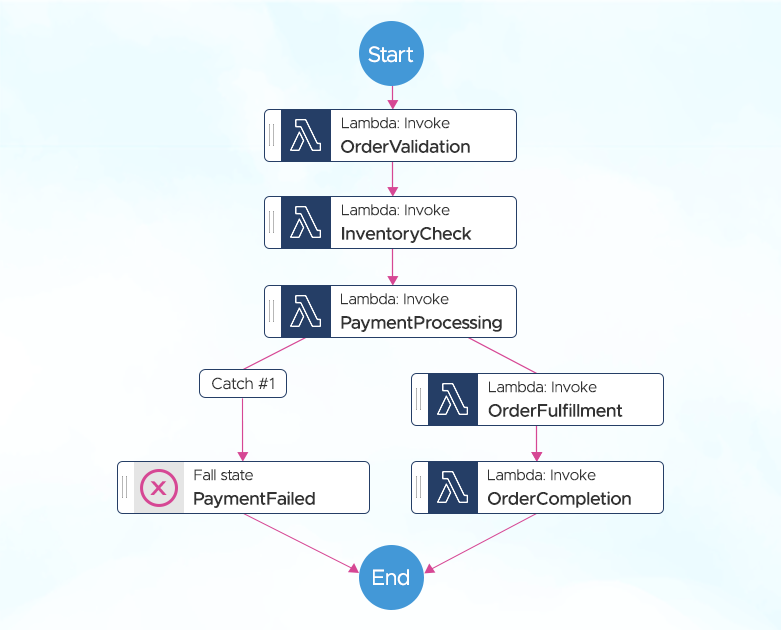In today's era of cloud computing, serverless architectures have gained immense popularity due to their scalability, cost-effectiveness, and ease of management. AWS Step Functions is a full service offered by Amazon Web Services (AWS) that enables developers to build and coordinate complex workflows effortlessly. In this blog post, we will explore the capabilities of Step Functions, delve into their cost considerations, leverage their use to reduce AWS costs and highlight some real-world use cases where Step Functions excel.
Understanding Step Functions
AWS Step Functions is a fully managed service that allows you to design and visualize workflows using a state machine-based approach. It simplifies the process of orchestrating and coordinating multiple AWS services and custom actions, eliminating the need for manual management and enabling robust error handling.
Key Features and Benefits
1. State Machine Design: Step Functions enable you to design workflows as a collection of states, representing individual tasks or actions. These states can be arranged to create sophisticated workflows, allowing for sequential, parallel, or conditional execution.
2. Visual Representation: With Step Functions, you can visualize your workflows using a graphical interface, making it easier to understand and communicate the logic of your application. The visual representation provides an intuitive view of the entire workflow and helps in identifying bottlenecks or areas for optimization.
3. Fault Tolerance and Error Handling: Step Functions automatically handle retries, timeouts, and error handling, ensuring your workflows are robust and resilient. Suppose an error occurs during the execution of a state. In that case, you can define error-handling strategies such as retrying the state, branching to an error-handling state, or stopping the execution altogether.
4. Integration with AWS Services: Step Functions seamlessly integrate with various AWS services, allowing you to orchestrate complex workflows involving Lambda functions, ECS (Elastic Container Service) tasks, Glue jobs, Batch jobs, SNS (Simple Notification Service) notifications, and more. This integration enables you to leverage the full power of AWS without the need for complex manual coordination.
Cost Considerations
When considering the cost of Step Functions, it's important to understand that you are charged for two main components:
1. State Transition Costs: AWS charges based on the number of states transitions your workflows make. A state transition occurs when a state changes to another state, and the cost varies based on the region and the number of transitions. It is crucial to optimize your workflows to minimize unnecessary transitions and reduce your AWS bill.
2. State Execution Costs: This cost is associated with the duration of state execution, which depends on the resources consumed by each state. The execution time includes the time taken by AWS services like Lambda or ECS tasks. Optimizing the execution time by designing efficient state logic and resource allocation helps in effective AWS cost management.
Reduce AWS costs with Step Functions
By utilizing Step Functions, you can bring down your AWS bill in several ways:
1. Eliminating Idle Resources: With Step Functions, you only pay for the actual execution time of your workflows. There are no idle resources running in the background when workflows are not being executed. This means you can avoid the cost of running servers, databases, and other resources that are not being used.
2. Improved Resource Utilization: By using Step Functions, you can optimize resource utilization by coordinating and orchestrating distributed applications and services in a more efficient manner. This means you can avoid overprovisioning resources and paying for more than what you actually need. This is one of AWS cost optimization’s best practices.
3. Reduced Developer Effort: With Step Functions, developers can build and manage workflows using a visual interface, rather than having to write and manage custom code. This reduces the time and effort required to build and maintain workflows and allows developers to focus on other critical aspects of their applications.
4. Reduced Operational Overhead: Step Functions automatically manage the scaling and availability of your workflows, eliminating the need for operational overhead such as managing servers, databases, and other infrastructure components. This results in reduced costs associated with maintaining and scaling your applications.
Overall, AWS Step Functions can help reduce AWS costs by optimizing resource utilization, eliminating idle resources, reducing developer effort, and reducing operational overhead.
Use Cases for Step Functions
1. ETL (Extract, Transform, Load) Pipelines: Step Functions are ideal for orchestrating complex ETL pipelines. By integrating with AWS Glue, Step Functions can coordinate the execution of various transformation steps, handle errors, and provide visibility into the overall progress of the pipeline.
2. Media Processing Workflows: Step Functions can orchestrate the processing of multimedia assets by coordinating Lambda functions, Elastic Transcoder, and other AWS services. For example, you can create a workflow to resize images, transcode videos, and generate thumbnails in parallel or sequentially, ensuring efficient utilization of resources.
3. Order Processing and Fulfillment: Step Functions can be used to automate order processing workflows, from capturing orders to managing inventory, payment processing, and shipping notifications. The ability to handle error scenarios and retry failed states ensures the reliability of the order fulfillment process.
4. Serverless Microservices: Step Functions can serve as a coordination layer for serverless microservices, enabling complex interactions between multiple services.
Let's explore a real-time use case for AWS Step Functions, including a cost estimation and a workflow diagram.
Use Case: Order Processing Workflow
Description:
Imagine an e-commerce platform that processes customer orders through a series of steps, including order validation, inventory check, payment processing, and order fulfillment. To handle this workflow efficiently and ensure proper AWS cost management, you can leverage AWS Step Functions.
Workflow Steps:
1. Order Validation: Verify the order details, including item availability, customer information, and order validation rules.
2. Inventory Check: Query the inventory system to ensure that the ordered items are in stock and available for shipment.
3. Payment Processing: Initiate the payment processing workflow, which may involve making API calls to payment gateways, validating payment details, and capturing the payment.
4. Order Fulfillment: Once the payment is confirmed and inventory is available, initiate the process to fulfill the order, including packaging, labeling, and shipping.
5. Order Completion: Send notifications to the customer with order confirmation details, tracking information, and any additional updates.
Cost Estimation:
The cost of using AWS Step Functions depends on the number of state transitions, state executions, and the duration of each execution. In this use case, let's assume an estimated cost breakdown based on typical usage:
- State Transitions: Each step in the workflow represents a state transition. Assuming an average of 5 state transitions, the cost is approximately $0.000025 per state transition.
- State Executions: The number of state executions depends on the number of orders processed. Assuming 10,000 orders are processed per month, with an average of 5 state executions per order, the cost is approximately $0.000004 per state execution.
- Execution Duration: The cost is based on the duration of each execution state. Assuming an average duration of 10 seconds per state execution, the cost is approximately $0.00000014 per second.
Workflow Diagram:
Below is a simplified workflow diagram for the Order Processing Workflow using AWS Step Functions:

It's important to consider that the cost estimation provided is a rough approximation. While implementing AWS cost optimization practices, it is important to consider actual usage patterns, state execution durations, and any additional AWS service integrations or data transfers involved.
Cloudkeeper, with its promise to provide guaranteed cost savings to up to 25%, helps its customers to optimize their spending through different optimization techniques, including Step Functions. We recommend reading our whitepaper on how to ace cloud optimization through pricing and other aspects.








